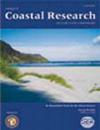Dynamics and Dispersion in the Coastal Boundary Layer off Coffs Harbour in Eastern Australia
4区 地球科学
Q3 Earth and Planetary Sciences
引用次数: 5
Abstract
PRITCHARD, T.R., HOLDEN, C, LEE, R.S., BLACK, K.P. and HEALY, T. 2007. Dynamics and Dispersion in the Coastal Boundary Layer off Coffs Harbour in Eastern Australia. Journal of Coastal Research, SI 50 (Proceedings of the 9th International Coastal Symposium), 848 – 857. Gold Coast, Australia, ISSN 0749.0208 Time series analysis and model simulations defined dynamics of coastal boundary layer formation off Coffs Harbour based on four deployed acoustic Doppler current (ADCP) meters and wind data from Coffs Harbour airport. Variance preserving spectra revealed peak energies at 7.8, 3.9 and 2.5 days plus ~24 and ~12 hours consistent with dominant forcing by winds. At inshore sites the highest energy levels occurred at the surface and decrease uniformly with depth at all frequencies with local peaks centred at exactly 24 hours, corresponding to peak local wind energy. In contrast, offshore sites showed depth dependency in the peak spectral energy with evidence of regional influences and wave-guide effects due to density stratification. Hydrodynamic simulations using the 3-dimensional explicit finite difference model 3DD revealed local bathymetric controls on circulation. A coastal boundary layer, delineated by a shear zone ~2km offshore in the lee of Corambirra Point, south of Coffs Harbour, was associated with formation of transient eddies. Model simulations and independent ADCP data identified 3 dimensional flow structures typified by clockwise rotation of flows down through the water column at all sites except for the quiescent, shallow water site in the headland wake south of Corambirra Point. The area south of Corambirra Point was predisposed to clockwise eddy rotation while offshore flows were generally shore-parallel. Pollutant dispersal was shown to be significantly less within this coastal boundary layer thus highlighting the need to consider effects of coastal boundary layers when locating discharges such as ocean outfalls.澳大利亚东部科夫斯港沿海边界层的动力学和扩散
PRITCHARD, T.R., HOLDEN, C, LEE, R.S., BLACK, K.P. and HEALY, T. 2007.Dynamics and Dispersion in the Coastal Boundary Layer off Coffs Harbour in Eastern Australia.Journal of Coastal Research, SI 50 (Proceedings of the 9th International Coastal Symposium), 848 - 857.澳大利亚黄金海岸,ISSN 0749.0208 时间序列分析和模型模拟,根据四个部署的声学多普勒海流(ADCP)计和科 夫斯港机场的风力数据,确定了科夫斯港沿岸边界层形成的动力学。方差保存谱显示,7.8、3.9 和 2.5 天加上 ~24 和 ~12 小时的峰值能量与风的主要作用相一致。在近岸站点,最高能量水平出现在海面上,并且在所有频率上都随深度均匀下降,局部峰值正好集中在 24 小时,与当地风能峰值相对应。与此相反,近海站点的频谱能量峰值与深度有关,表明密度分层产生了区域影响和波导效应。利用三维显式有限差分模型 3DD 进行的水动力模拟显示,局部水深对环流有控制作用。在科 夫斯港南部科兰比拉角附近,由离岸约 2 公里的剪切带划定的沿岸边界层与瞬态漩涡的形 成有关。模型模拟和独立的 ADCP 数据确定了三维流动结构,其典型特征是水柱中的水流向下顺时针旋转,科兰比拉角以南岬角唤醒区的静止浅水区除外。科兰比拉角以南的区域倾向于顺时针方向的涡旋,而近海水流一般与海岸平行。在这一沿岸边界层内,污染物的扩散量明显减少,这突出表明,在确定排污口(如 海洋排污口)位置时,需要考虑沿岸边界层的影响。
本文章由计算机程序翻译,如有差异,请以英文原文为准。
求助全文
约1分钟内获得全文
求助全文
来源期刊

Journal of Coastal Research
地学-地球科学综合
自引率
0.00%
发文量
87
审稿时长
3-8 weeks
期刊介绍:
The Journal of Coastal Research (JCR) is one of the leading international journals for coastal studies and processes, and is published bi-monthly by the Coastal Education & Research Foundation [CERF]. By covering the entire field of coastal research, the JCR encompasses all subjects relevant to natural and engineered environments (freshwater, brackish, or marine) and the protection/management of their resources in the vicinity of coastlines of the world. Even though the journal broadly focuses on immediate shoreline zones, the JCR also embraces those coastal environments that either reach some indefinite distance inland or that extend seaward beyond the outer margins of the sublittoral (neritic) zone. The JCR disseminates accurate information to both the public and research specialists around the world on all aspects of coastal issues in an effort to maintain or improve the quality of our planet''s shoreline resources.
 求助内容:
求助内容: 应助结果提醒方式:
应助结果提醒方式:


